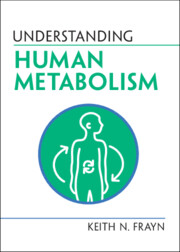Book contents
- Understanding Human Metabolism
- Series page
- Understanding Human Metabolism
- Copyright page
- Reviews
- Contents
- Foreword
- Preface
- Acknowledgements
- 1 What Is Metabolism?
- 2 Metabolic Fuels
- 3 Metabolic Pathways
- 4 Communication Systems in Human Metabolism
- 5 ATP: The Common Currency of Metabolic Energy
- 6 Metabolism in Daily Life
- 7 Metabolism Is So Adaptable
- 8 Metabolic Interactions between Nutrients
- 9 Metabolic Disorders
- Concluding Remarks: Human Metabolism in Context
- Summary of Common Misunderstandings
- References
- Figure Credits
- Index
4 - Communication Systems in Human Metabolism
Published online by Cambridge University Press: 25 August 2022
- Understanding Human Metabolism
- Series page
- Understanding Human Metabolism
- Copyright page
- Reviews
- Contents
- Foreword
- Preface
- Acknowledgements
- 1 What Is Metabolism?
- 2 Metabolic Fuels
- 3 Metabolic Pathways
- 4 Communication Systems in Human Metabolism
- 5 ATP: The Common Currency of Metabolic Energy
- 6 Metabolism in Daily Life
- 7 Metabolism Is So Adaptable
- 8 Metabolic Interactions between Nutrients
- 9 Metabolic Disorders
- Concluding Remarks: Human Metabolism in Context
- Summary of Common Misunderstandings
- References
- Figure Credits
- Index
Summary
I’ve been sitting at the computer for too long. It’s time to go for a walk. My brain tells my leg muscles to move. This is almost instantaneous. The proteins within the muscles start using energy to contract – to slide past each other. That energy comes from ATP, the energy in which is, in turn, derived from the breakdown of nutrients. There is glycogen (carbohydrate) stored in the muscles, as we have seen, and this can sustain the contractions for a short time, but if I am going for a long, slow walk, then more fuel will be needed. As we have seen, there’s lots of it in my fat stores. So a signal tells my fat stores it’s time to get the enzymes in the fat cells working to break down the stored triacylglycerols, and release some fatty acids that can travel through the bloodstream to my muscles. I shall probably also need to use some glucose that my liver can produce for me from its own glycogen store. In addition, as I get going, my heart needs to beat faster to pump more blood to my muscles (to carry not just the fatty acids and glucose, but also oxygen) and to remove the waste products, in this case carbon dioxide and lactic acid, which is a breakdown product of the glucose. So there are signals racing around my body, telling particular organs and tissues to do particular things in a very coordinated way.
- Type
- Chapter
- Information
- Understanding Human Metabolism , pp. 43 - 58Publisher: Cambridge University PressPrint publication year: 2022



